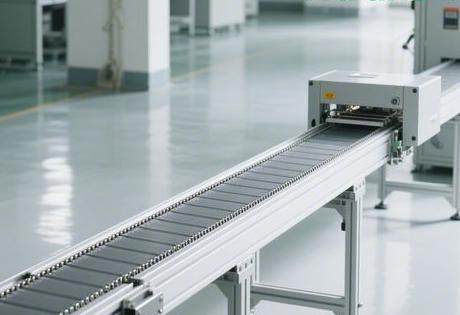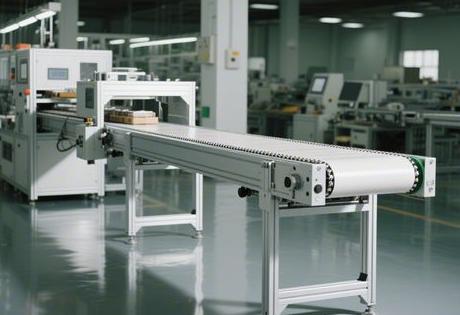I. Physical architecture: 60 seconds to reconstruct the topological code of the production line
At the heart of the 60S multiplier chain lies itsTopologically optimised aluminium alloy cavity structureIt is designed to achieve quantum-level balance between space compression and dynamic loading through mechanical reconfiguration of the 55 x 85mm cross section (2.0mm wall thickness lightweight version and 3.0mm heavy-duty version). Its breakthrough design embodies:

- Diamond mesh reinforcement: Density up to 8 bars/m, bending stiffness up to 81%, 30m long chain droop error <0.3mm
- Anodised composite layerSurface hardness: HV400, acid and alkali resistance life is extended by 5 times, suitable for electrophoretic coating and other corrosive scenes.
- Plug-in F-rail: Millimetre fast disassembly and assembly, line modification cycle time compressed from 72 hours to 8 hours
A new energy battery factory measured: 1.5 tonne pole roll conveying offset of only 0.05mm, synchronous accuracy of 99.3% - thanks to theHydraulic interlocking tensioning systemControl chain sag to 0.3mm/m level.
II. The nature of multiplication: the mechanical relativity of diameter differences
The 60S multiplier chain of3x Speed MysteryDerived from the design of the precision diameter ratio of the roller (D) to the roller (d). When D=38mm and d=12mm, according to the kinematic formula:
Vtooling board
= (1 + D/d) × Vsprockets
= 3.17Vsprockets
This mechanical leverage allows the chain to run at a low speed of 15m/min (wear reduction of 60%), while the work plate gains a high speed of 47.5m/min. Key technological breakthroughs include:
- Molybdenum disulphide nano-coated rollers: Stable friction coefficient 0.06, -25℃ ambient speed fluctuation <±0.5%
- Double Degree of Freedom Roller ArchitecturePure rolling contact with guide rail, energy consumption down 18%, noise pressure to 68dB (national standard 85dB).
plaintextmake a copy of■ Semiconductor workshop validation: wafer breakage rate reduced from 0.3‰ to 0.001‰, cleanliness exceeding ISO Class 5 standards
III. Scenario Fission: Millimetre Breakout from Chip Cleanrooms to Explosion-Proof Workshops
High Density Vertical Factory Programme::
| parameters | Conventional production lines | 60S Speed Chain Programme |
|---|---|---|
| spatial density | 120 pieces/㎡ on a single level | 450 pieces/㎡ on the third floor |
| Ramp angle | 15° limit | 30° Z-climb |
| Installation cycle | 72 hours | 8-hour modular splicing |
Extreme Environment Adaptation Technology::
- Fully sealed ionic air curtain: Particle release <100 pcs/m³, static voltage dissipation <15V (fragmentation rate 0.001‰)
- Magnesium-aluminium alloy explosion-proof chain plate: Spark fugitive energy <0.1mJ, meets ATEX Zone 2 standard.
- PTFE + ceramic molecular coatingExtend the life of hydrochloric acid corrosion resistance by 8 times, and extend the replacement cycle of electrophoresis line to 2 years.
The case of ethanol conveying line transformation: the accident rate goes to zero, and the inspection efficiency is improved by 50%.

IV. Intelligent Leap: Edge Computing Reconstructs the Drive Nerve
Distributed FPGA control networkEnding the signal delay paradox:
- Embedded chip nodes per metre: Signal delay compressed from 15ms to 0.8ms, stopping accuracy of ±0.3mm for tooling boards.
- Three-parameter chaos diagnosis: Temperature/vibration/current synergistic analysis, fault false alarm rate <0.3%
Quantum-level predictive maintenance system::
- Acoustic Crack Detection: Capture of 50 μm defects (72 hours advance warning)
- magnetorheological damping array: Resonance energy absorption rate of 921 TP3T, downtime reduction of 901 TP3T
plaintextmake a copy ofAero-composite workshop data: 12m wing girder delivery pass rate 99.98%, OEE increased to 94%
Ask Yourself: 60S Chain Three Questions to Break the Boundary
Q1: How can aluminium profiles withstand 1.5 tonne pole rolls?
Composite Stress Dispersion Model::
- 55 x 85mm cross-section embeddedcellular topologyLocal pressure dispersion rate 81%
- Inva alloy thermal compensation layer: -40℃~150℃ deformation <±0.1mm
plaintextmake a copy ofPV silicon ingot line test: 1.8 tonnes load conveyance without deformation, bearing life extension by 3 timesQ2: Do acidic environments corrode growth rate organisations?
Molecular self-healing technology::
- Self-healing in 48 hours for anodic oxide scratches <50μm depth
- The rollers are made ofModified polyurethane materials: -30°C modulus of elasticity retention 90%
Northeast lithium battery workshop: -25 ℃ stalling rate down 90%, lubrication cycle 8000 hoursQ3: Is it economical to retrofit small and medium-sized factories?
Lightweight Retrofit Kit::
① 220V micro servo motor: 0.75kW unit embedded every 5 metres, compatible with existing circuits.
② Plug-in rail: no welding installation, 24 hours to complete the production line upgrade
③ Modular rack: 40 * 80mm profile self-weight reduction of 60%, load-bearing inverse increase of 30%.
When a 60S chain carrying wafers glides with ±0.01mm precision in a Class 10,000 clean room, its value has transcended the conveying tool itself - it is rewriting theCurvature equations for industrial space. I think the next generation of 60S chains will evolve toStress-space-time converterWhen carbon nanotube sensors convert lattice vibrations into positioning signals, and when topological insulator coatings allow frictional heat to drive a sprocket wheel, the ultimate metric of manufacturing efficiency will be upgraded from "times faster" to "times faster".Space compression ratio.. The metallic reflections of the aluminium rails at this moment are the optical proof of the leap from the physical factory to the digital twin.
[Exclusive data insights]
In 2026, the penetration rate of 60S profile in small and medium-sized factories will exceed 40% (annual increase of 1,20%), of whichvertical circulation architecturecontributing 70% increments.Carbon fibre composite chain plateCosts are down 451 TP3T annually - which means.Output per cubic metre of space is replacing land area as the new hard currency for manufacturing.













